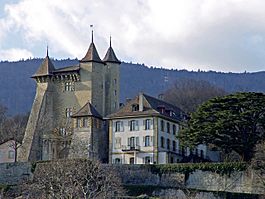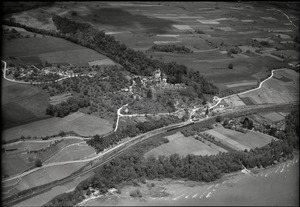Vaumarcus facts for kids
Quick facts for kids
Vaumarcus
|
||
|---|---|---|

Vaumarcus Castle
|
||
|
||
| Country | Switzerland | |
| Canton | Neuchâtel | |
| District | Boudry | |
| Area | ||
| • Total | 1.78 km2 (0.69 sq mi) | |
| Elevation | 447 m (1,467 ft) | |
| Population
(December 2007)
|
||
| • Total | 248 | |
| • Density | 139.3/km2 (360.9/sq mi) | |
| Postal code |
2028
|
|
| Surrounded by | Châbles (FR), Concise (VD), Estavayer-le-Lac (FR), Font (FR), Fresens, Mutrux (VD), Saint-Aubin-Sauges | |
| Twin towns | Vira (Gambarogno) (Switzerland) | |
Vaumarcus is a place in Switzerland. It used to be its own municipality, which is like a small town or local area with its own government. Vaumarcus is located in the canton of Neuchâtel, in the Boudry district.
On January 1, 2018, Vaumarcus joined with several other nearby places. These included Bevaix, Saint-Aubin-Sauges, Gorgier, Montalchez, and Fresens. Together, they formed a new, larger municipality called La Grande-Béroche.
Contents
History of Vaumarcus
Vaumarcus is a very old place. It was first written about in the year 1227. Back then, it was known by a slightly different name: Valmarcuel.
Later, in 1875, Vaumarcus became one municipality by joining with another area called Vernéaz. For a long time, until 1966, the combined area was known as Vaumarcus-Vernéaz.
Where is Vaumarcus Located?
Vaumarcus covers an area of about 1.8 square kilometers (which is about 0.7 square miles). A big part of this land, about 59%, is used for farming. This means people grow crops or raise animals there.
Another large part, about 23.6%, is covered by forests. The rest of the land, about 16.9%, has buildings or roads on it. A very small part, less than 1%, is land that cannot be used for anything.
What is the Vaumarcus Coat of Arms?
A coat of arms is a special design that represents a place or family. The coat of arms for Vaumarcus has a blue background. On it, there is a silver "chevron," which looks like an upside-down V shape. On this silver chevron, there are three red roses. Around the chevron, there are also three silver crosses.
People Living in Vaumarcus
Vaumarcus has a population of about 248 people. In 2008, about 17% of the people living there were from other countries. Over ten years, from 2000 to 2010, the number of people living in Vaumarcus grew by about 22%. This growth happened because more people moved there and more babies were born than people who passed away.
Most people in Vaumarcus speak French. About 93% of the population speaks French as their main language. A smaller number of people speak German (about 4%) or Italian (about 2%).
In 2008, the population was almost evenly split between males and females. About 50.2% were male and 49.8% were female. Many people living in Vaumarcus were born there or in the same canton (region) of Switzerland. Some were born in other parts of Switzerland or outside the country.
Young people, from babies to teenagers (0-19 years old), make up about 25.7% of the population. Adults (20-64 years old) make up the largest group at 61.3%. Older adults (over 64 years old) make up about 13.1%.
In 2000, there were 77 households in Vaumarcus. On average, about 2.4 people lived in each home. Most of the apartments in Vaumarcus were lived in all the time. A few were used only during certain seasons, and a very small number were empty.
The chart below shows how the population of Vaumarcus has changed over many years:

Important Historical Sites
One very important historical place in Vaumarcus is called La Redoute Des Bourguignons. This site is very old, going back to prehistoric times. It includes a tumulus, which is a mound of earth or stones built over a burial place. This site is so important that it is listed as a Swiss heritage site of national significance. This means it is a protected place that tells us a lot about the past.
How People Work in Vaumarcus
In 2010, the unemployment rate in Vaumarcus was 4.4%. This means that about 4.4% of people who wanted to work could not find a job.
Many people in Vaumarcus work in different types of jobs:
- Primary Sector: This includes jobs like farming. In 2008, about 22 people worked in this area, with 6 businesses.
- Secondary Sector: This includes jobs like manufacturing (making things) or construction (building things). About 36 people worked in this sector, with 6 businesses.
- Tertiary Sector: This includes jobs that provide services, like working in shops, restaurants, or offices. About 60 people worked in this sector, with 11 businesses.
In 2008, there were 97 full-time jobs in Vaumarcus. Most of these jobs were in agriculture, manufacturing, or services like sales and restaurants.
Many people who live in Vaumarcus travel to other places for work. Also, many people from other areas come to Vaumarcus to work. This means Vaumarcus has more workers coming in than leaving. Most people (about 64.6%) use a private car to get to work, while a smaller number (about 3%) use public transportation.
Religion in Vaumarcus
According to a survey in 2000, people in Vaumarcus follow different religions:
- About 16.2% were Roman Catholic.
- About 57.1% belonged to the Swiss Reformed Church.
- A small number of people belonged to other Christian churches or were Islamic.
- About 22.5% of the population did not belong to any church, or they were agnostic (not sure if God exists) or atheism|atheist (do not believe in God).
- A few people did not share their religious preferences.
Education in Vaumarcus
Many adults in Vaumarcus have completed a good amount of schooling. About 41.4% have finished upper secondary education, which is like high school. About 18.8% have gone on to higher education, like university.
In the canton of Neuchâtel, where Vaumarcus is located, most children go to two years of non-required kindergarten. After that, they have five years of required primary school. Then, for the next four years of required secondary education, students often travel to larger schools in other towns.
The kindergarten in Vaumarcus is shared with the nearby municipality of St-Aubin-Sauges. In the 2010-2011 school year, there were 3 kindergarten classes with 50 students in total from both areas. In the same year, there was one primary school class in Vaumarcus with 17 students.
In 2000, 15 students from Vaumarcus went to schools outside of their municipality.
See also
 In Spanish: Vaumarcus para niños
In Spanish: Vaumarcus para niños






